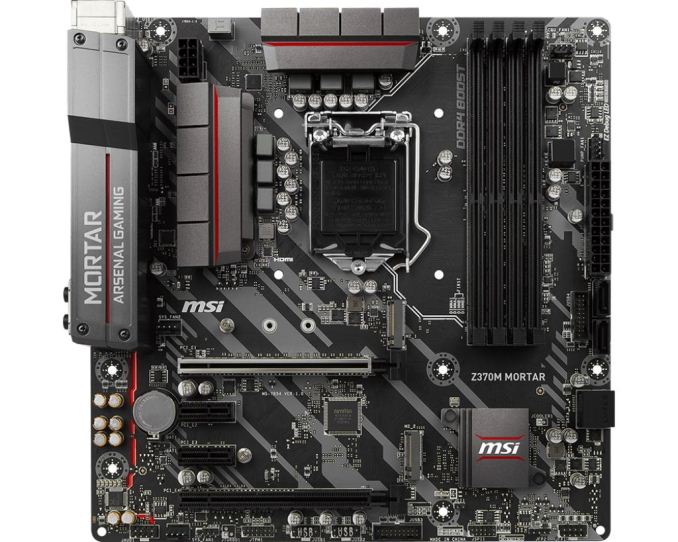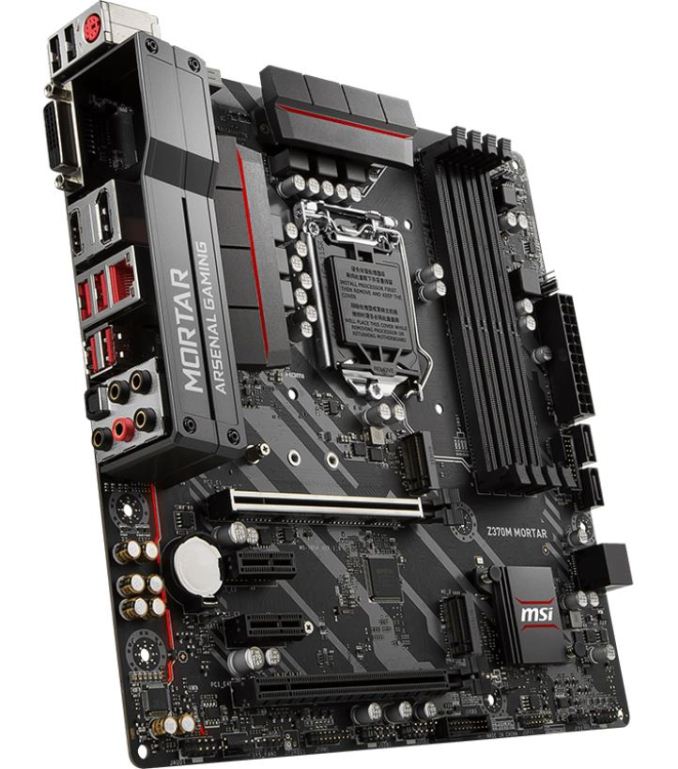Analyzing Z370 for Intel's 8th Generation Coffee Lake: A Quick Look at 50+ Motherboards
by Ian Cutress, Anton Shilov, Joe Shields & Gavin Bonshor on October 20, 2017 2:00 PM ESTMSI Z370M Mortar
The Mortar’s appearance does have a more rugged look compared to the other MSI micro-ATX board, the Z370M Gaming Pro AC. The Mortar’s back panel cover looks like it was taken from a military vehicle with the aesthetic only screws on both ends giving it an industrial feel. The heatsinks are simple grey with a red line through the middle, in contrast to the jet black PCB that has some grey design features on the board. There are no onboard RGB LEDs, with the only support provided through an onboard header. A single full-length PCIe slot is reinforced, with the focus for this board on single GPU setups. The PCH heatsink is a diminutive piece with the MSI name on it in white letters with red accents and is attached via pushpins.
MSI still uses all four memory slots here, capable of up to 64 GB and on-the-box speeds of DDR4-4000. Despite the industrial feel to the board, there is no memory slot reinforcement here, and MSI has used dual-sided latch mechanisms over the single-sided latch versions we sometimes see on high-end motherboards. For PCIe, the top reinforced slot handles the main add-in card duty, supporting PCIe 3.0 x16 direct from the processor. The other full-length slot is a PCIe x4 slot from the chipset, and the board also has two smaller PCIe x1 slots in between.
As with the other MSI micro-ATX board, there is only four SATA ports here, with two in a 'regular' position and the other two sitting vertically on the board just below the 24-pin ATX connector. These last two are also right next to a USB 3.0 internal header, and in a position that might make it difficult to release locking SATA cables if a front panel cable is attached to the USB 3.0 header. Other storage comes via dual M.2 slots, with the Mortar supporting 80mm drives in both, however, the first slot is PCIe only, with the second slot able to do both PCIe and SATA.
The Mortar will accept a total of four fans with its 4-pin headers, two of which are located around the chipset. The 4-pin headers support both PWM and voltage control. Network connectivity is through a sole Intel I219-V gigabit Ethernet controller, with the price of this board meaning that Wi-Fi is not present. The audio codec is also lower than 'normal' to save a few pennies, however the Realtek ALC892 codec still offers 7.1 channel support. MSI has at least offered some PCB separation to reduce electrical interference with the audio paths.
USB Support for the Mortar is missing the latest USB 3.1 (10 Gbps), but it has a total of eight USB 3.1 (5 Gbps) ports: there are four Type-A on the back panel, and four more available through the two internal headers. The board also has two USB 2.0 ports on the back panel and two internal headers. The rest of the Mortar’s panel consists of a combination PS/2 port, DVI-D/HDMI/DisplayPort video outputs, the network connection, and the audio jacks with SPDIF.
| MSI Z370M Mortar | |
| Warranty Period | 3 Years |
| Product Page | Link |
| Price | N/A |
| Size | Micro-ATX |
| CPU Interface | LGA1151 |
| Chipset | Intel Z370 Express |
| Memory Slots (DDR4) | Four DDR4 Supporting 64GB Dual Channel Support DDR4 4000+ |
| Network Connectivity | 1 x Intel I219-V |
| Onboard Audio | Realtek ALC892 |
| PCIe from CPU | 1 x PCIe 3.0 x16 slots |
| PCIe from Chipset | 1 x PCIe 3.0 x4 2 x PCIe 3.0 x1 slots |
| Onboard SATA | 4 x Supporting RAID 0/1/5/10 |
| Onboard SATA Express | None |
| Onboard M.2 | 2 x PCIe 3.0 x4 Slot 1 PCIe only Slot 2 PCIe or SATA |
| Onboard U.2 | None |
| USB 3.1 (10 Gbps) | N/A |
| USB 3.1 (5 Gbps) | 4 x Back Panel 2 x Headers |
| USB 2.0 | 2 x Back Panel 2 x Headers |
| Power Connectors | 1 x 24-pin EATX 1 x 8-pin ATX 12V |
| Fan Headers | 1 x 4-pin CPU 1 x 4-pin Waterpump 2 x 4-pin System Fan (All PWM or Voltage controlled) |
| IO Panel | 1 x Combination PS/2 2 x USB 2.0 1 x DisplayPort 1 x DVI-D port 1 x HDMI port 1 x LAN (RJ45) port 4 x USB 3.1 (5 Gbps) Type-A ports 5 x Audio Jacks + SPDIF |












83 Comments
View All Comments
risa2000 - Saturday, October 21, 2017 - link
It seems that the PCB which holds the silicon has changed between the 7th and the 8th gen. So they most likely needed to validate the CPU. The fact that they did not move the notch means they just did not want to (could not) introduce a new socket. Either because there were so many of the old ones, or there was no time, or they did not want to push the cost to MB manufacturers to revalidate the new sockets.shabby - Friday, October 20, 2017 - link
For a split second i thought finally some x370 goodness... but no.Shame, shame, shame!
tamalero - Saturday, October 21, 2017 - link
I'm waiting for actual non clown disco BS Threadripper motherboards :(ikjadoon - Friday, October 20, 2017 - link
Amazingly well done. Excellent write-up.AbRASiON - Friday, October 20, 2017 - link
Stupid question, I got the AsRock simple ITX board and it won't turbo my CPU at all (8400) like no turbo PERIOD. It never ever goes over 2763mhz?Anyone got any ideas on this? Am I just stupid and this is normal behaviour or what?
https://forums.anandtech.com/threads/am-i-doing-so...
bernstein - Friday, October 20, 2017 - link
FYI: GIGABYTE Z370N-WiFi is also HDMI 2.0 capableByte - Friday, October 20, 2017 - link
If nothing else, Asus makes some damn good looking boards.docbones - Friday, October 20, 2017 - link
My big question still on the z370 is whats the 390 going to bring? Will the 370 not support a octocore chip?shabby - Friday, October 20, 2017 - link
This is intel we're talking aboot, new chip = new mobo period.Ro_Ja - Saturday, October 21, 2017 - link
Once Kaby Lake E is released, that's a new mobo again.